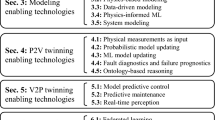Abstract
For over one hundred years of history of electric motor, there has been no major change to the original invention and early development of the technology. The double-rotor motor (DRM) as discussed in some recent patent disclosures and in a few research publications for the first time ever is to cause some substantial change to the very definition of electric motor, its mechanism and applications. This paper discusses the theoretical insight into the DRM and explores the actual potentials of the same.

Similar content being viewed by others
References
R. Qu, T.A. Lipo, Design and parameter effect analysis of dual-rotor, radial-flux, toroidally wound, permanent-magnet machines, In IEEE Transactions on Industry Applications. 40(3), 771–779 (2004) online https://ieeexplore.ieee.org/document/1300731. Accessed 10th Oct 2020.
P. Gottipati, Comparative study on double-rotor PM brushless motors with cylindrical and disc type slot-less stator. M.Sc. Thesis, Department of Electrical & Computer Engineering, Louisiana State University (2007) online https://digitalcommons.lsu.edu/cgi/viewcontent.cgi?article=2784&context=gradschool_theses. Accessed 10th Oct 2020.
C. Liu, K.T. Chau, Electromagnetic design and analysis of double-rotor flux-modulated permanent magnet machines. Progress in Electromagnetics Research 131, 81–97 (2012) online http://www.jpier.org/PIER/view/12060605/. Accessed on 12th Dec 2020.
C. Yunyun, Q. Li, Z. Xiaoyong, W. Hua, Z. Wang, Electromagnetic performance analysis of double-rotor stator permanent magnet motor for hybrid electric vehicle. IEEE Trans. Magn. 48(11), 4204–4207 (2012). https://doi.org/10.1109/TMAG.2012.2206374
Y. Yeh, M. Hsieh, D.G. Dorrell, Different arrangements for dual-rotor dual-output radial-flux motors. In IEEE Transactions on Industry Applications 48(2) 612–622 (2012) online https://ieeexplore.ieee.org/document/6112715. Accessed 10th Oct 2020.
H.T. Lee Christopher, K.T. Chau, C. Liu, Electromagnetic design and analysis of magnetless double-rotor dual-mode machines. Progress in Electromagnetics Research 142, 333–351(2013) online http://www.jpier.org/PIER/view/13061712// Accessed 10th Oct 2020.
P. Pisek, B. Stumberger, T. Marcic, P. Virtic, Design analysis and experimental validation of a double rotor synchronous PM Machine used for HEV. IEEE Trans. Magn. 49(1), 152–155 (2013). https://doi.org/10.1109/TMAG.2012.2220338
N. Sameer, S. A. Prashanth, A. Dalal, P. Kumar, Design and optimization of dual rotor motor for electric vehicle application, In 2014 IEEE International Conference on Power Electronics, Drives and Energy Systems (PEDES), Mumbai. pp. 1–5, (2014) https://doi.org/10.1109/PEDES.2014.7042122.
D. Adamczyk, A. Wilk, M. Michna, Model of the double-rotor induction motor in terms of electromagnetic differential. Archives of Electrical Engineering 65(4) 761–772 (2016) online http://journals.pan.pl/dlibra/publication/117503/edition/102172/content.
R.J. Wishart, Increased efficiency counter-rotating electric motor for propelling a boat. US Patent No. US008198773B2 (2012) online https://patentimages.storage.googleapis.com/ec/a0/8c/c2fef30cec2629/US8198773.pdf.
R.J. Wishart, Increased Efficiency Dual Rotational Electric Motor/Generator. U.S. Patent No. 8,253,294 B1 (2012) online https://patentimages.storage.googleapis.com/eb/58/6a/259167ffac62dc/US8253294.pdf.
B. Roy, A novel double rotor without stator electric motor: theoretical and functional aspects. J. Electr. Eng. Sci. 3(2), 1–10 (2017). https://doi.org/10.18831/djeee.org/2017021001
D.H. Kelly, Double-rotor induction motor. IEEE Trans. Power Appar. Syst. 88(7), 1086–1092 (1969). https://doi.org/10.1109/TPAS.1969.292509
Funding
The author declares no funding.
Author information
Authors and Affiliations
Corresponding author
Ethics declarations
Conflict of interest
The author declares no conflict of interests.
Additional information
Publisher's Note
Springer Nature remains neutral with regard to jurisdictional claims in published maps and institutional affiliations.
Rights and permissions
Springer Nature or its licensor (e.g. a society or other partner) holds exclusive rights to this article under a publishing agreement with the author(s) or other rightsholder(s); author self-archiving of the accepted manuscript version of this article is solely governed by the terms of such publishing agreement and applicable law.
About this article
Cite this article
Roy, B. Advantages of Double-Rotor Electric Motors: A New Motor Equation. J. Inst. Eng. India Ser. B 104, 43–49 (2023). https://doi.org/10.1007/s40031-022-00834-3
Received:
Accepted:
Published:
Issue Date:
DOI: https://doi.org/10.1007/s40031-022-00834-3




